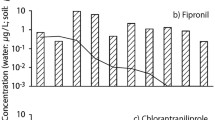Abstract
Imidacloprid was added to laboratory aquatic microcosms at concentrations of 12, 24, 48 and 96 μg/L to determine effects on leaf-shredding aquatic insect survival and feeding rates, and on aquatic microbial decomposition of leaf material. Survival of the stonefly, Pteronarcys dorsata, was significantly reduced at 48 and 96 μg/L. There was no significant mortality of the cranefly, Tipula sp., but most surviving tipulids were very sluggish and non-responsive to prodding at 48 and 96 μg/L. Leaf decomposition by these leaf-shredding insects was significantly reduced at all test concentrations. There were no significant adverse effects on microbial decomposition of leaf material.

Similar content being viewed by others
References
Abelho M (2001) From litterfall to breakdown in streams: a review. Scientific World 1:659–680
Elbert A, Becker B, Hartwig J, Erdelen C (1991) Imidacloprid - a new systemic insecticide. Pflanzenschutz-Nachrichten Bayer 44:113–136
Felsot AS, Cone W, Yu J, Ruppert JR (1998) Distribution of imidacloprid in soil following subsurface drip chemigation. Bull Environ Contam Toxicol 60:363–370
Kidd H, James E (eds) (1994) Agrochemicals handbook, third edition. Royal Society of Chemistry, Cambridge, England
Kreutzweiser DP, Good KP, Chartrand DT, Scarr TA, Thompson DG (2007) Non-target effects on aquatic decomposer organisms of imidacloprid as a systemic insecticide to control emerald ash borer in riparian trees. Ecotoxicol Environ Saf 68:315–325
Overmyer JP, Mason BN, Armbrust KL (2005) Acute toxicity of imidacloprid and fipronil to a nontarget aquatic insect, Simulium vittatum Zetterstedt cytospecies IS-7. Bull Environ Contam Toxicol 74:872–879
Poland TM, Haack RA, Petrice TR, Miller DH, Bauer LS (2006) Laboratory evaluation of the toxicity of systemic insecticides for control of Anoplophora glabripennis and Plectrodera scalator (Coleoptera: Cerambycidae). J Econ Entomol 99:85–93
Richardson JS (1992) Food, microhabitat, or both? Macroinvertebrate use of leaf accumulations in a montane stream. Freshwat Biol 27:169–176
Sanchez-Bayo F, Goka K (2006) Ecological effects of the insecticide imidacloprid and a pollutant from antidandruff shampoo in experimental rice fields. Environ Toxicol Chem 25:1677–1687
Sheets LP (2001) Imidacloprid: a neonicotinoid insecticide. In: Krieger RI (ed) Handbook of pesticide toxicology, second edition. Academic Press, San Diego, California, pp 1123–1130
Smelt JH, Scorza RP Jr, Hendriks RFA, Boesten JJTI (2003) Preferential transport of imidacloprid in a cracking clay soil. Proc XII Sym Pest Chem, Placenza, Italy, June 12–17, pp 319–326
Song ME, Stark JD, Brown JJ (1997) Comparative toxicity of four insecticides, including imidacloprid and tebufenozide, to four aquatic arthropods. Environ Toxicol Chem 16:2494–2500
Wanner KW, Helson BV, Harris BJ (2002) Laboratory evaluation of two novel strategies to control first-instar gypsy moth larvae with spinosad applied to tree trunks. Pest Manag Sci 58:817–824
Webster JR, Benfield EF, Ehrman TP, Schaeffer MA, Tank JL, Hutchens JJ, D’Angelo DJ (1999) What happens to allochthonous material that falls into streams? A synthesis of new and published information from Coweeta. Freshwat Biol 41:687–705
Wilkins R (2000) Leaching and persistence of imidacloprid and diuron in a citrus crop in Valencia. Fresenius Environ Bull 9:638–645
Acknowledgments
Technical assistance was provided by Scott Capell, Mandy Roberts and Korrie Young. The study was supported in part by the Enhanced Pest Management Methods S&T Program of Natural Resources Canada.
Author information
Authors and Affiliations
Corresponding author
Rights and permissions
About this article
Cite this article
Kreutzweiser, D.P., Good, K.P., Chartrand, D.T. et al. Toxicity of the Systemic Insecticide, Imidacloprid, to Forest Stream Insects and Microbial Communities. Bull Environ Contam Toxicol 80, 211–214 (2008). https://doi.org/10.1007/s00128-007-9347-8
Received:
Accepted:
Published:
Issue Date:
DOI: https://doi.org/10.1007/s00128-007-9347-8




